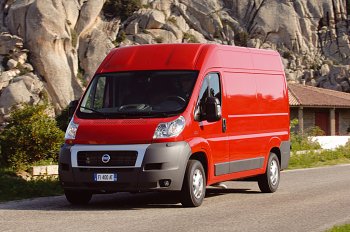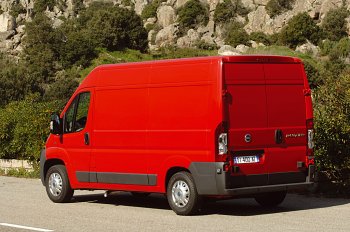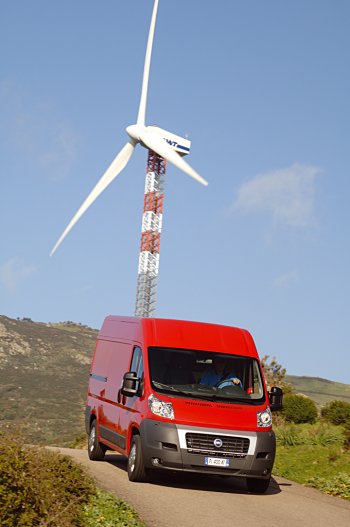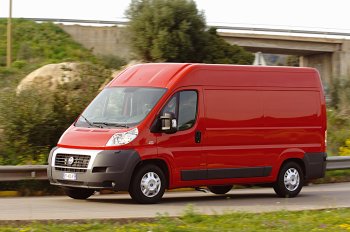|
HEIR TO A BEST
SELLER
|
|
The Ducato has
always been a greatly appreciated vehicle. It is popular
with small businesses working within the craft, trades,
building, farming, maintenance and service sectors. But it
also appeals to major industry, special customers (local
organisations, police forces, government, health
organisations etc), bodyshops-conversion shops specialising
in the leisure sector (campers, caravans, motorhomes) or
special public transport vehicles (minibuses, school buses,
ambulances, disabled vehicles) and goods vehicles (box
trucks, insulated trucks, armoured vehicles for transporting
valuables, mobile shops).
People buy it due to rational, practical factors such as
previous experience with the same brand, price, size and
load capacity, performance, reliability, quality, dealer
efficiency and service. These are joined by other more
emotional reasons associated with the way the vehicle
behaves on the road, comfort, handling, performance and the
level of equipment. The reasons for its success lie in the
great versatility that it has shown over all these years. We
must take this as a starting point if we are to appreciate
the numerous new features that the New Ducato brings to its
segment.
Fiat Ducato: a success story
The Ducatoís extraordinary versatility first became apparent
in 1981 with the first series and grew, year in year out,
until it reached a turning point in 1994 with the launch of
the second series. The stylists now began to treat it not as
a single basic model with many specification variants but as
many different vehicles specialised for different payload
categories and operational missions. The designers, on the
other hand applied engineering criteria and state-of-the-art
modular structural methods to create no fewer than 500 Fiat
Ducato variants (i.e. different combinations of body type,
mechanical units and engines). The public immediately
confirmed that the chosen formula was the right one: volumes
and market shares exceeded our expectations in the first
year alone. And the motoring press acknowledged the
vehicleís innovative features by awarding the Ducato the
title ĎVan of the Year 1994í.
The Fiat Ducato has had another ace up its sleeve all these
years, i.e. the vitality that comes from Fiatís constant
attention to vehicle technical development and on-going
range updates in terms of body types, engines and equipment.
In 1997, we saw the arrival of the Sofim 2.8 i.d. TD engine
(122 bhp of maximum power, 285 Nm of torque), a natural
development of the 2.5 TDI. Two new versions of the Fiat
Ducato were also created: the Panorama and Combi with medium
wheelbase and high sides that offer greater roominess, more
comfort and more luggage space. The conversion base range
also benefited from specific options and version variants
able to aid the bodyshops in their task.
The operation was also repeated with success in 2000, when
we saw the arrival of the Fiat Ducato 2.8 JTD Common Rail
with 127 bhp of maximum power and 300 Nm of torque (the most
popular member of the range). 2002 saw the arrival of the
third generation Fiat Ducato, whose strength lay in the fact
it offered many strengths, because it was flexible,
innovative, dynamic and satisfying to see and use in
everyday activities. 2002 also saw the launch of the Bipower
versions Ė duel fuel methane and petrol systems Ė while two
years later came the turn of the lively 2.8 JTD POWER, a
common rail turbo diesel with variable geometry turbine and
intercooler that developed 146 bhp of power and a torque of
310 Nm (as opposed to the 127 bhp and 300 Nm of the 2.8 JTD
with fixed geometry turbo). Now comes the turn of the New
Fiat Ducato to take up the baton and continue to be one of
the most appreciated and biggest-selling light commercial
vehicles in Europe.
History of the joint venture
between the Fiat and PSA Peugeot CitroŽn Groups
Since 1978, the date on which Sevel (Societŗ Europea Veicoli
Leggeri) was set up in Atessa (CH), cooperation between the
Fiat Group and the PSA Peugeot CitroŽn Group has offered a
blend of engineering and manufacturing know-how that places
it at the cutting edge of the European light commercial
vehicle sector. Work started at the Val di Sangro plant in
1981, when the output was 350 vehicles per day. The plant
was then extended to cope with the manufacture of more
products, until levels reached the current capacity of 900
vehicles per day (including the Ducato for Fiat and the
Peugeot Boxer and CitroŽn Jumper for PSA Peugeot CitroŽn).
|



 |
|
 |
|
|
 |
|
|
 |
|
|
|
This number will rise by more than 10% upon the marketing
launch of the new vehicle family. On 15 December 2005, we
reached our production target of 3 million vehicles. If all
these vehicles were placed end to end, they would form a
line 15,000 km long, roughly the distance between Val di
Sangro and Sydney.
Boosted by its great marketing success throughout Europe,
the joint venture between the Groups consolidated over the
years and now satisfies most of the demand from light
commercial vehicle customers. In January 2002, the agreement
was extended to 2017. The continuation of this fruitful
cooperation allows both partners to achieve major synergies
in the design and production of the new X250 (the code
identifying new generations of the Fiat Ducato, Peugeot
Boxer and CitroŽn Jumper) that will be manufactured in the
Val di Sangro Sevel plant, where annual production may rise
to 260,000 units. For this reason, more than 1.1 bn Euros
have been allocated, of which 700 million are earmarked for
the development of the new product and equipping of the
suppliers. The other 400 million Euros have been set aside
to extend the panel and assembly shops, add new production
machinery, produce a new logistics depot and a new paint
shop equipped with the most up-to-date technology. The
partners have an equal holding and the plant is managed by
Fiat Auto.
Sevel: a record-breaking
factory
The Sevel (Societŗ Europea Veicoli Leggeri) plant in Val di
Sangro, Italy is the largest light commercial vehicle
assembly plant in
Europe. The factory, set up in 1981 as part of a joint
venture partnership between Fiat and PSA Peugeot CitroŽn, is
located between the towns of Atessa and Paglieta in the
Province of Chieti. It covers an area of more than 1,200,000
square metres (120 hectares), of which 344,000 are covered (34
hectares), and is equipped for the entire manufacturing
cycle: panel working, painting and assembly.
It currently employs 5200 people (more than 95% of whom live
in Abruzzo). Two hundred and fifty articulated trucks enter
its gates every day carrying parts, and 200 low loaders and
4 trains leave every day bearing the finished products. And
more: the Panel shops manufacture some 300 different types
of body, the Paint shop uses 122 colours and the Assembly
shop produces more than 6000 versions and more than 150
options. These incredible numbers are the result of the wide
range of requirements of our professional users and the
fleets that Sevel products have to satisfy. One of Sevelís
many strengths is its ability to manage product complexity.
As confirmation of the high regard in which the vehicle is
held in the market, manufacturing has continued unabated for
25 years. Far from taking a break, production, employment
and investments have risen steadily. The plant also meets
the highest standards of quality and respect for the
environment: the quality system is Iso 9001 certified
(Vision 2000) and the environmental management system has
achieved Iso 14001 certification.
One major breakthrough is Sevelís new painting system. This
is one of the most advanced systems of its type in Europe in
terms of technology and respect for the environment (the use
of water-based enamel is one example.) The building is 330
metres long and 60 metres wide. It houses 150 workers per
shift and 23 robots to apply the sealant and enamel. Not to
mention the cataphoretic baths and the drying and stoving
ovens. All automated. The employees are responsible only for
supervising the process and monitoring the result. The
preparation of surfaces for painting is also a partly
automatic process: this is done by emu feather rollers that
are particularly suitable for the task because they do not
become charged with static electricity by friction.
Unlike cars, light commercial vehicle bodies are also
painted inside because the surfaces of cargo versions are
visible. For this reason, some 65 square metres of sheet
steel must be coated for each New Ducato vehicle: this
requires 10 kilograms of enamel and 137 metres of sealant.
In one year, we use 25 million metres, roughly four times
the earthís radius. Lastly, the new painting system offers a
well-ventilated, light, noiseless environment. This has been
achieved through the use of a powerful air exchange system
and vehicle conveyor lines that use rubber belts and are
therefore silent.
The light commercial vehicle
market
Over the past ten years, the European light commercial
vehicle market has enjoyed a growing trend, rising from some
1,300,000 units in 1995 to more than 2 million in 2005. And
these numbers tell us that even today the Fiat Ducato is
always at the top of the European best-seller lists (some
100,000 sold in 2005) and first place in the Italian lists:
last year, approximately 35,000 vehicles were delivered for
a market share of more than 37%. And more. In the leisure
conversion sector, the Fiat model has achieved European
leadership in recent years: two camper vans out of three are
now built on Ducato bases. This percentage exceeded 72% in
Germany, in 2004. The credit goes to the technical
specifications of a vehicle that has been designed for easy
conversion by body shops.
These important results have contributed to the achievement
of leadership by the Fiat Light Commercial vehicle brand in
Italy: in 2005, deliveries rose to 87,350 and the market
share rose overall to more than 40% (in Europe it was
10.7%). The credit goes to the outstanding performances by
all our main models (Punto Van, DoblÚ Cargo, Scudo and
Ducato) that head the sales rankings in their respective
segments. This confirms we offer a broad range with a good
level of quality that is always in line with customer needs. |
|